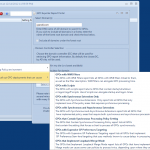Today I’m happy to announce that SDM Software has released our 2.0 version of GPO Exporter! I’m really excited about this release because I think it represents a new milestone in an organization’s ability to get insight and add manageability to Group Policy as a configuration management tool for Windows. As I had blogged previously, there’s a bunch of cool stuff we’ve included in this new release, not the least of which is a new set of freely available reports for determining whether your Group Policy deployments may be impacting desktop performance within your environment! These free “Slow Boot/Slow Logon Reports” (see below) are available to anyone that downloads and installs the Demo version, available when you register on our site for a free evaluation.
We’re planning on publishing a quick whitepaper in the next week that will provide details around how you can use these special reports to make good decisions about your Group Policy environment. In addition, we’ve added support for Windows 8 and Server 2012 to the product, so you can install this version on your Windows 8 workstations and get the same great functionality as the Windows 7 version! In addition to these cool features, we’ve added the following capabilities:
- Ability to “Select last settings used” during an export so that you don’t have to re-pick the same set of GPOs for subsequent exports.
- “Use current export data for this report” checkbox to make reports use the currently exported GPO data as the basis for the reports instead of using all GPOs in the selected domains.
- Improved UI for picking GPOs from the list to be exported.
- New view in the GPO browse list, which is based on a domain’s OU structure and how they are linked/organized in AD.
- “Include Sub Domains” checkbox to display GPOs from both the root and sub domains of the root domain you specify. If the box is not checked but the root domain is entered, then only the root domain’s GPOs will appear.
- “Domain Controller(s) In use” link in lower right of main screen, for instant display of the currently utilized domain controllers for a given export.
- Full support for all new reports within the GPO Exporter PowerShell module.
- New x64 version takes full advantage of x64 architecture for larger environments.
So visit our website to check out this new version or click on the video demo I’ve done, at the top of this blog post, to take a tour of what’s new in GPO Exporter 2.0!
Thanks,
Darren



I think this GPO Exporter v2.0 is an excellent tool. I’ll give it 4 stars ****. The only issue I have with it is that when you export GPOs and they show up in the grid, the grid lists Domain name, GPO name, setting path, and the setting value. How come the grid doesn’t list the GPO Links? I really think the product will be complete if we can also see the GPO Links in here. I see that you can only see the GPO Links only when you run the Report or in the Report Portal.
Thank you,
Tee Darling
Tee-
You can include metadata in an export. Metadata will include the links for each GPO exported. They don’t appear on the same line as the setting but they are listed.
Thanks for the feedback!
Darren